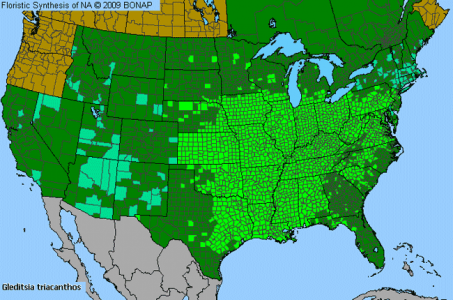Honey Locust
Gleditisia triacanthos L.
Description
Honey locust or thorny locust is a eudicot that is part of the pea family (Fabaceae)¹. It is a medium sized tree that can range from 30-75 feet on average². These trees have alternate, pinnately compound leaves with paired leaflets¹. They are known for their thorns that can be found on their branches and trunk which can be up to 15 centimeters in length³. Grayish, blackish bark covers the trunk¹. The bark had deep, narrow grooves that separate into plates¹. This tree produces small greenish, yellow flowers in the spring. The trees are “polygamous-dioecious,” meaning that some are strictly dioecious with male and female flowers on separate trees; some have bisexual flowers with male flowers on the same tree; and some have bisexual flowers with female flowers on the same tree.6 The dried fruit called legumes in the form of flattened seed pods that are up to 45 centimeters long.1,2 These are dark brown and have sticky sweet pulp inside that surrounds their seeds, this is where the common name came from¹.

Leaves, thorns, flowers and fruit of honey locust. Paul Nelson, Missouri Department of Conservation7
Distribution
The honey locust is found primarily in the United States but can be found in other countries¹. Although other countries sometimes consider it a “weed tree”¹. The primary range of this tree is from the great plains of Midwest states like South Dakota and Kansas to the eastern states of Pennsylvania and Maryland¹. It is also found in the southern U.S from eastern Texas to Alabama¹. Honey locusts thrive in conditions of full sun and moist soil². The thornless cultivar is planted throughout North America, expanding its distribution from the native distribution in Southeastern and Midwestern US.

Distribution of honey locust. Yale University Nature Walk8.
Wildlife Importance
The seed pods of the honey locust are an important food source for wide variety of wildlife including; deer, opossums, rabbits, squirrels, and raccoons⁴. Domesticated animals like sheep and cattle also eat the pods⁴. Deer may also use its bark as a food source¹. The flowers the tree produces are important for pollinators like butterflies and moths². The honey locust is also the host plant of silver-spotted skippers, bicolored honey locust moth, and the bisected honey locust moth². As a host plant, it is one of the only plants these species can lay their eggs on, their population’s survival is heavily dependent on the existence of the honey locust.
Economic Importance
Honey locust wood is dense, stiff, strong, and durable under contact with soil, so it is used for posts and pallet on small scale⁵. It is not common enough to be used economically on a large scale⁵. It has been ground down into feed for livestock as a source of protein⁵. The honey locust is also used as an ornamental tree in landscaping⁵. They are also good for preventing soil erosion and providing a wind barrier¹.
Threats
In general, honey locusts do not have many threats compared to other tree species¹. They have thin bark which can make them extremely susceptible to fire damage⁵. The only major disease that honey locusts sometimes get are cankers, these are not typically fatal¹. Young honey locust are more at risk due to being used as a food source for wildlife like deer and rabbits⁵.
Interesting Facts
-
- Native Americans would dry the seed pods and ground up the pulp to use it as a sweetener. However, it has been reported that the pulp can irritate the throat and even be toxic¹.
- Honey locust trees do not start producing seeds until the age of 10 but can continue to produce seeds up until the age of 100!¹
- The ability of their seeds to germinate is enhanced when they pass through the digestive tract of an animal¹.
- Honey locust, unlike other legumes, does not form an association with Rhizobium to fix nitrogen5.
References
- National Resource Conservation Service, USDA Plant Guide
- Lady Bird Johnson Wildflower Center: Gleditsia triacanthos
- Department of Agriculture and Fisheries, Invasive plant risk assessment: Honey locust
- Nebraska Forest Service: Honeylocust
- USDA-Forest Service Fire Effects Information System: Gleditsia triacanthos
- USDA-Forest Service Silvics, Vol. 2. Hardwoods: Gleditsia triacanthos
- Missouri Department of Conservation: Honey locust
- Yale Nature Walk: Honey locust
Contributed by M. Phillips
